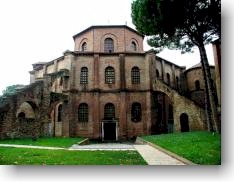
San Vitale
The Basilica of San Vitale
sits within a complex of buildings, nicely maintained within a lawned open
space, despite its center city location.
It takes a bit to orient yourself to the various buildings because
the basilica is connected to the National Museum, and it is through this
that you gain entrance to the basilica by passing back outside through a
pretty enclosed loggia. The
first thing that we noticed was how the entire basilica sits several feet
lower than everything around it. Why
is it that ancient buildings seem to sink and eventually even get buried?
The building is a very unusual and quite a beautiful form. It is a
double octagon, one on top of the other.
I really found it a very peaceful place, but of course, there is
great excitement at the fabulous mosaics.
We were really astonished at the colors.
A great deal of green, and so vibrant.
We were very lucky that it was not at all crowded so we could take
as much time as we wished to study the mosaics.
There was a group of young students sitting in a section of pews
listening attentively as their teacher described the art. We couldn’t help watching them.
They were so intent. So interested. So mesmerized. So quiet. So
polite. It didn’t seem
possible that our American students could sit still for several hours to
study works of art. We were impressed and very jealous.
One of the basilica’s doors leads
to the lawn and a path to the Mausoleo di Gala Placidia, which
should not be missed. This
small round building has beautiful mosaics.
After we entered, a small tour group came in and the guide closed
the door, blocking any light save for that that passed through the
alabaster windows. Quite
beautiful. It is in this
mausoleum that are the famous mosaics of the Lamb of God and the doves
drinking from the fountain. While
heading back to the basilica I was struck to notice that it had flying
buttresses. How odd, I
thought. I had always been
told in school that the flying buttress was invented in France in the
Gothic period to allow for the great height of the cathedrals with their
huge stained glass windows. I
even checked this when I got home and the Abbey at St. Denis is credited
with the first flying buttresses in 1160.
So I don’t know the answer as to why this building from 560 A.D.
has flying buttresses. The
only rational answer would seem to be that they were added in the Middle
Ages in order to strengthen the building.
Picture
Gallery: San Vitale & Gala Placidia Mausoleum
Click for larger image
|
|

Central Nave View
|
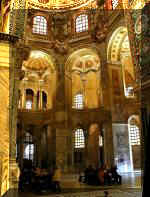
San Vitale showing Matroneum (woman's gallery)
|
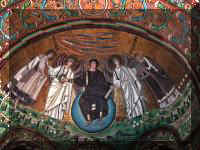
Apse of San Vitale with beardless, youthful Christ flanked by
Angels introducing St. Vitalis.
|
|
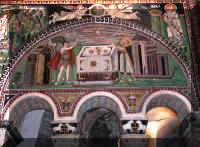
San Vitale Lunette with mosaic depicting sacrifices of Abel and
Melchisedech.
|
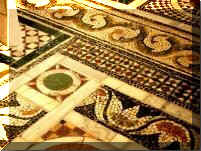
San Vitale floor mosaic.
|
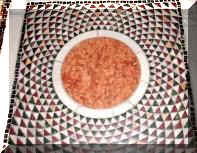
Geometric floor design, San Vitale.
|
|
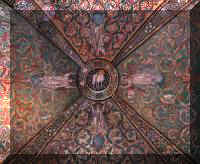
Dome Ceiling of The Tomb of Galla Placidia.
|
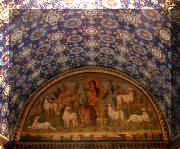
The Good Shepard Mosaic with Intricate Blue domed ceiling in The
Tomb of Galla Placidia
|
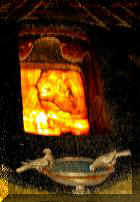
Alabaster Window in the Tomb of Galla Placidia
with the famous mosaic of drinking Doves
|
After visiting the basilica we
actually headed into the museum – something I would normally skip.
We traversed hall after hall where we were totally alone, the
guides turning on the lights as we entered each gallery. It is a pretty large museum with an impressive collection.
There is an entire wing of icons.
Beautiful, but there are miles of them.
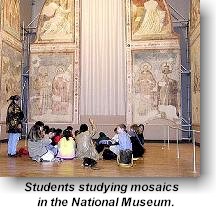 Kris went crazy when we entered one gallery that consisted of an
entire ancient pharmacy that was removed form the center city and dates
from several centuries ago. It
is very impressive. As we
came back to the entrance where we bought our tickets, we walked into a
large gallery where there was another group of young students.
They were sitting in a circle on the floor studying the frescos on
the walls and ceiling. They
were exactly in the same spot when we entered several hours before! Kris went crazy when we entered one gallery that consisted of an
entire ancient pharmacy that was removed form the center city and dates
from several centuries ago. It
is very impressive. As we
came back to the entrance where we bought our tickets, we walked into a
large gallery where there was another group of young students.
They were sitting in a circle on the floor studying the frescos on
the walls and ceiling. They
were exactly in the same spot when we entered several hours before!
Leaving the complex, we needed some
bum time to give our feet a rest.
Come rest with us and then continue our journey.
|